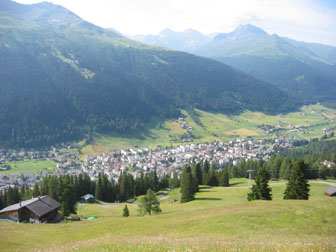Davos
 They began
in the middle of the 13th century to systematically settle larger
regions of today’s Kantons Graubünden with people from Wallis. Thus, the largest German-Language colonies in
the otherwise Roman language area developed in Davos and in the area of Hinterrheins.
They began
in the middle of the 13th century to systematically settle larger
regions of today’s Kantons Graubünden with people from Wallis. Thus, the largest German-Language colonies in
the otherwise Roman language area developed in Davos and in the area of Hinterrheins.
With the Lehensbrief (loan letter) of 1289 the Walser in today’s Davos received the right of autonomy. As the first Landammann (from Land and “Amt” man) they voted for the leader of the settlers, Wilhelm Beeli. All goods went in to hereditary ownership of the individual families. From now on they were justified in extending their ownership over the area from Davos and further. As a result of this Monstein, Wiesen and Arosa developed, which belonged to Davos as a parliamentary group until 1851. In return the Davoser had to pay their protector interest in the form of natural goods and participate in Military service.
These Freiheitsbrief (Liberty Letter) is considered to be one of the first Gemeindeordnungen (Gemeinde orders) in Bündner Freistaat.
After the extinction of der Vazer, different hereditary portions and the death of his last Herrn, the Grafen (Count) Friedrich von Toggenburg, decided to bring together the areas Davos to Maienfeld, das Schanfigg, das Albulatal and Churwalden and in 1436 established the Zehngerichtebund. (Ten-Court Federation). Davos became the Vorort (vgl. Turm von St. Johann and Ratsstube) thanks to its political meaning and its high number of inhabitants.
This federation existed until 1807, although the Kanton Graübunden had already joined the Bund der Eidgenossen in1803.
In the
middle of the century before, the physician Alexander Spengler discovered the
healing effects of Davo’s high altitude climate. Thus, an upswing never suspected began. Starting in 1865 Davos became the most
important and largest lung health resort in Europe.
Davos as research-, congress-, sport-, and
hospital, holiday destination: From the health resort, Davos developed as a
research destination. The knowledge
compiled here – particularly in the area of natural science and medicine – was
passed on in courses at the beginning of the 20th century. In particular the medical training courses
led to the construction of the Kongresszentrums (congress centre) Davos in
1969. The Kongressort (Congress destination)
Davos became internationally renowned through the World Economic Forum (WEF –
in former times the Management symposium), which has taken place at the end of
January in Landwassertal since 1971.
Since the year 1870 English-men, here as patients and health guests, used sports as the best way to keep busy; they were particularly interested in winter sports and its various art forms. From this, Davos developed as a sports destination.
In 1944, with the discovery of Streptomycin[1], the boom time in Davos was for the time being over. The sanatoriums, which remained and were not converted into hotels, are partly filled again particularly with patients who stay here to heal asthmatic problems, skin diseases or to undertake rehabilitation.
Davos has succeeded, from it’s beginnings as a Walserdorf, to a sanatorium city, to a centre for Sport, for Congresses from economics and science, in becoming a successful city with diverse cultural offerings.
Text: Klaus Bergamin
Source: www.gemeinde-davos.ch
[1] An antibiotic, C21H39O12N7, produced by the actinomycete Streptomyces griseus, used to treat tuberculosis and other bacterial infections.









